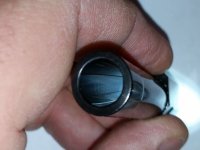barrybenson1776
Inactive
Last week, I bought a brand new P938 SAS model. It has a born on date of 03/08/16, so it's very new. I also own a P226 that I've had for over 15 years.
I have not shot or used it at all. When I went to clean it, I inspected the barrel, and I immediately noticed odd ripple marks in the grooves in the inside of the barrel that are present throughout the entire barrel. The lands seem normal and smooth, aside from what I hope is just copper fouling.
I called Sig customer service, exchanged emails and pictures, and they said it's normal. The rep stated that he checked some P238 barrels, and they were like this too. He didn't mention if he checked P938 barrels. He also said it is most likely from the broaching process of rifling the barrels.
Can anyone take a look at this and let me know if their P938 barrel is like this?
It seems really odd to me, and I have not seen this before. I'm especially concerned because of the very high price of this gun. I'm really curious to see if anyone else has these. If it will not hurt anything, then I'll just live with it. If it turns out to affect accuracy or fouling, then I'll insist on a replacement.
Also, can replacement barrels just be swapped out, or do they need some type of fitting?
Thanks for your time!!
Please let me know what you think. See the attached picture.
I have not shot or used it at all. When I went to clean it, I inspected the barrel, and I immediately noticed odd ripple marks in the grooves in the inside of the barrel that are present throughout the entire barrel. The lands seem normal and smooth, aside from what I hope is just copper fouling.
I called Sig customer service, exchanged emails and pictures, and they said it's normal. The rep stated that he checked some P238 barrels, and they were like this too. He didn't mention if he checked P938 barrels. He also said it is most likely from the broaching process of rifling the barrels.
Can anyone take a look at this and let me know if their P938 barrel is like this?
It seems really odd to me, and I have not seen this before. I'm especially concerned because of the very high price of this gun. I'm really curious to see if anyone else has these. If it will not hurt anything, then I'll just live with it. If it turns out to affect accuracy or fouling, then I'll insist on a replacement.
Also, can replacement barrels just be swapped out, or do they need some type of fitting?
Thanks for your time!!
Please let me know what you think. See the attached picture.

